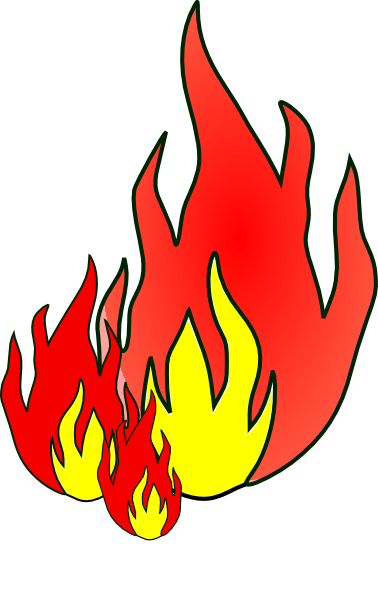So we're reading Becoming a Word Learner for class. And so far it's striking me as an extension of First Language Acquisition—everyone's got a different model.
The first chapter is "Word Learning: Icon, Index or Symbol?", which seems like a good place to start the discussion about learning words. After all, you need to show what it is that people are doing when they learn words. The way the authors, Golinkoff and Hirsh-Pasek, do that is by looking at attempts to teach non-humans human languages. (They say infrahuman, but I don't like the term. It smacks of chain of being, which I detest.) And to get to a human understanding of language, you need to be in possession of what they call symbol. Animals can, for the most part, only manage icon and index. But the part that bothers me is that I can't quite draw the distinction between index and symbol.
Icon seems pretty straightforward. An icon is a representation of the thing itself. Here's an icon of fire.
See? It's not a fire, but it looks like fire. There seems to be some dispute as to just how much resemblance is necessary, but I'm going to ignore that.
The next remove is index. An index is either something that is correlated with or points to something. So for fire, smoke is an index. Other indexes of fire might be: heat, wood, camping, cooking, matches. So here's a picture of smoke, which is an index of fire.
The problem comes in with symbol. At this page (a somewhat less in-depth discussion than in G and H-P), symbols are "easily removed from context" and "associated with large sets of other words". Ok, so far so good. I can talk about fire with none being present, as well as knowing that it as an association with other words like smoke, heat, wood, camping, cooking, and matches.
If you're curious, you can browse the book here. Why not? It's pretty interesting so far.
The first chapter is "Word Learning: Icon, Index or Symbol?", which seems like a good place to start the discussion about learning words. After all, you need to show what it is that people are doing when they learn words. The way the authors, Golinkoff and Hirsh-Pasek, do that is by looking at attempts to teach non-humans human languages. (They say infrahuman, but I don't like the term. It smacks of chain of being, which I detest.) And to get to a human understanding of language, you need to be in possession of what they call symbol. Animals can, for the most part, only manage icon and index. But the part that bothers me is that I can't quite draw the distinction between index and symbol.
 |
| An icon of fire |
See? It's not a fire, but it looks like fire. There seems to be some dispute as to just how much resemblance is necessary, but I'm going to ignore that.
 |
| An index of fire |
 |
| One symbol for fire (according to Wiktionary) |
Here's the problem, which strikes me as a father of young children. We talk a lot about the here and now at home, which means that we are talking about things that are not removed from context—particularly with my son (2;5). My daughter has made the leap to things that aren't present, i.e. her upcoming birthday party. So we're kind of defeating the benefit of a symbol. In fact, we're treating words like indexes. We don't say MILK unless there is milk somewhere nearby: or we are trying to get the milk from the fridge into a cup or something very concrete. The other thing is that while we are indexing MILK to milk, we are also indexing it to such things as cups, lunch, cold, cereal, spoons, fridge and the like. So we're somewhat taking advantage of the association with other words, but they too are indexed in the here and now.
Anyway. What I'm trying to get at is that I'm not seeing a clear line between index and symbol. Maybe at the ends of the index/symbol spectrum of goodness, it's clear. (Oooo, could it be a spectrum relationship?) Maybe as a child's ability to use language apart from the here and now develops, the child develops cognitive ability to make symbols out of indexes.
But there seems to be a lot of messy could-go-this-way or could-go-that-way and begging the question involved with indexes and symbols. If words are symbols, why are they so indexy early on? If words start their mental existence as indexes, then what transforms them into symbols? Do we even need to draw a distinction between index and symbol other than to say that a symbol is an index plus displacement? Or is this just another way that we're trying to separate man from beast without pointing at the actual neurological difference between what humans and, say, language-trained chimps are doing? I don't know. As usual here, more questions than answers. I absolutely promise interesting tools for learning new words in a second language before the end of summer. Cross my heart.
If you're curious, you can browse the book here. Why not? It's pretty interesting so far.